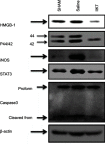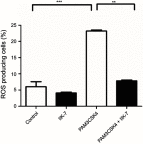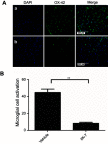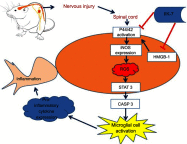Melatonin MT2 receptor agonist IIK-7 produces antinociception by modulation of ROS and suppression of spinal microglial activation in neuropathic pain rats
- PMID: 31496789
- PMCID: PMC6690853
- DOI: 10.2147/JPR.S214671
Melatonin MT2 receptor agonist IIK-7 produces antinociception by modulation of ROS and suppression of spinal microglial activation in neuropathic pain rats
Abstract
Background: In recent years, several melatonin (MLT) receptor agonists have been approved by FDA for the treatment of sleep disorders and depression. Very few studies have shed light on their efficacy against neuropathic pain (NP). IIK-7 is an MT-2 agonist known to promote sleep. Whether IIK-7 suppresses NP has not been reported, and the signaling profile is unknown.
Objective: To investigate the effect of melatonin type 2 receptor agonist IIK-7 on partial sciatic nerve transection-induced NP in rats and elucidate the underlying molecular mechanisms.
Methods: NP was induced by the PSNT in the left leg of adult male Wistar rats. On post-transection day 7, rats were implanted with intrathecal (i.t) catheter connected to an infusion pump and divided in to four groups: sham-operated/vehicle, PSNT/vehicle, PSNT/0.5 μg/hr IIK-7 and PSNT/0.5 μg IIK-7/1 μg 4-p/hr. To test the MT-2 dependence on IIK-7 activity, the animals were implanted with a single i.t catheter and injected MT-2 antagonist 4-Phenyl-2-propionamidotetralin (4-p) 20 mins prior to IIK-7 injection on day 7 after PSNT. The antinociceptive response was measured using a mechanical paw withdrawal threshold. Activation of microglial cells and the expression of NP-associated proteins in the spinal cord dorsal horn was assessed by immunofluorescence assay (IFA) and Western blotting (WB). Reactive oxygen species (ROS) scavenging ability of IIK-7 was evaluated by using bone marrow-derived macrophages (BMDM).
Results: Treatment with the MT-2 agonist IIK-7 significantly alleviated PSNT-induced mechanical allodynia and glial activation along with the inhibition of P44/42 MAPK, HMGB-1, STAT3, iNOS and casp-3 proteins.
Conclusion: IIK-7 attenuates NP through the suppression of glial activation and suppression of proteins involved in inflammation and apoptosis. MT-2 receptor agonists may establish a promising and unique therapeutic approach for the treatment of NP.
Keywords: IIK-7; MT-2 receptor; allodynia; neuropathic pain.
Conflict of interest statement
The authors report no conflicts of interest in this work.
Figures







Similar articles
-
Teneligliptin Co-Infusion Alleviates Morphine Tolerance by Inhibition of Spinal Microglial Cell Activation in Streptozotocin-Induced Diabetic Rats.Antioxidants (Basel). 2023 Jul 24;12(7):1478. doi: 10.3390/antiox12071478. Antioxidants (Basel). 2023. PMID: 37508016 Free PMC article.
-
The Melatonin Type 2 Receptor Agonist IIK7 Attenuates and Reverses Morphine Tolerance in Neuropathic Pain Rats Through the Suppression of Neuroinflammation in the Spinal Cord.Pharmaceuticals (Basel). 2024 Dec 5;17(12):1638. doi: 10.3390/ph17121638. Pharmaceuticals (Basel). 2024. PMID: 39770480 Free PMC article.
-
Teneligliptin Exerts Antinociceptive Effects in Rat Model of Partial Sciatic Nerve Transection Induced Neuropathic Pain.Antioxidants (Basel). 2021 Sep 9;10(9):1438. doi: 10.3390/antiox10091438. Antioxidants (Basel). 2021. PMID: 34573072 Free PMC article.
-
Manganese Oxide Nanozymes Ameliorate Mechanical Allodynia in a Rat Model of Partial Sciatic Nerve-Transection Induced Neuropathic Pain.Int J Nanomedicine. 2019 Dec 27;14:10105-10117. doi: 10.2147/IJN.S225594. eCollection 2019. Int J Nanomedicine. 2019. PMID: 31920306 Free PMC article.
-
The anti-inflammatory and analgesic effects of intraperitoneal melatonin after spinal nerve ligation are mediated by inhibition of the NF-κB/NLRP3 inflammasome signaling pathway.Brain Res Bull. 2021 Apr;169:156-166. doi: 10.1016/j.brainresbull.2021.01.015. Epub 2021 Jan 27. Brain Res Bull. 2021. PMID: 33508403
Cited by
-
The relationship between anesthesia and melatonin: a review.Front Pharmacol. 2023 Sep 19;14:1255752. doi: 10.3389/fphar.2023.1255752. eCollection 2023. Front Pharmacol. 2023. PMID: 37795029 Free PMC article. Review.
-
Role of Melatonin in the Regulation of Pain.J Pain Res. 2020 Feb 7;13:331-343. doi: 10.2147/JPR.S228577. eCollection 2020. J Pain Res. 2020. PMID: 32104055 Free PMC article. Review.
-
Teneligliptin Co-Infusion Alleviates Morphine Tolerance by Inhibition of Spinal Microglial Cell Activation in Streptozotocin-Induced Diabetic Rats.Antioxidants (Basel). 2023 Jul 24;12(7):1478. doi: 10.3390/antiox12071478. Antioxidants (Basel). 2023. PMID: 37508016 Free PMC article.
-
Identification of Key Genes and Pathways in Oxaliplatin-Induced Neuropathic Pain Through Bioinformatic Analysis.J Pain Res. 2024 May 3;17:1639-1650. doi: 10.2147/JPR.S452594. eCollection 2024. J Pain Res. 2024. PMID: 38716040 Free PMC article.
-
Neuro-Nutritional Approach to Neuropathic Pain Management: A Critical Review.Nutrients. 2025 Apr 29;17(9):1502. doi: 10.3390/nu17091502. Nutrients. 2025. PMID: 40362812 Free PMC article. Review.
References
-
- Kuthati Y, Lin S-H, Chen I-J, Wong C-S. Melatonin and their analogs as a potential use in the management of neuropathic pain. J Formos Med Assoc. 2018;118(8):1177–1186. doi:org/10.1016/j.jfma.2018.09.017 - DOI - PubMed
LinkOut - more resources
Full Text Sources
Research Materials
Miscellaneous

